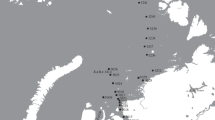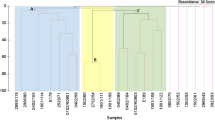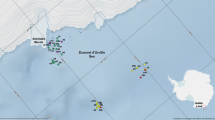Abstract
The bathymetric distribution of the 155 known species of Antarctic benthic hydroids has been studied with the aim of determining bathymetric groups and estimating the richness of the deep-sea Antarctic benthic hydroid fauna. Six bathymetric groups could be recognized on the basis of vertical zonation patterns. Most species have wide bathymetric ranges, but must nevertheless be considered shelf species. Although 62 species of benthic hydroids have been found in the Antarctic deep-sea, only 10 are strict inhabitants of that area. An inverse relative dominance between anthoathecate and leptothecate hydroids has been observed, with the former being more frequent in shallow waters.




Similar content being viewed by others
References
Andriashev AP (1964) Survey of the Antarctic fish fauna. Issled Fauny Morei 2:335–386 (in Russian)
Billard A (1906) Hydroïdes. Expéd scient Travailleur et Talisman 1906:153–243
Billard A (1914) Hydroïdes. In: Deuxième Expédition Antarctique Française (1908–1910) commandée par le Dr Jean Charcot. Masson, Paris. pp 1–34
Clarke A (2003) The polar deep seas. In: Tyler PA (ed) Ecosystems of the world, vol. 28: ecosystems of the deep oceans. Elsevier, Amsterdam, pp 239–260
Hartlaub C (1904) Hydroiden. Résult voyage S.Y. Belgica 1897–1899 (Zool) 7:1–19, pls 1-4
Jäderholm E (1905) Hydroiden aus antarktischen und subantarktischen Meeren, gesammelt von der schwedischen Südpolarexpedition. Wiss Ergebn Schwed Südpolarexped 1901–1903 5:1–41, pls 1-14
Naumov DV, Stepan’yants SD (1962) Hydroida (Thecaphora) collected by the Soviet Antarctic Expedition on the M/V ’Ob’ in antarctic and subantarctic waters. In: Biol Res Soviet Antarct Exped, 1955–1958, 1. Issled Fauny Morei 1:68–106
Naumov DV, Stepan’yants SD (1972) Marine invertebrates from Adélie Land collected by the XIIth and XVth French Antarctic Expeditions. 3. Hydroida. Téthys 4 [Suppl]:25–60
Peña Cantero AL (1998) Two new antarctic species of the genus Schizotricha Allman, 1883 (Cnidaria, Hydrozoa). Polar Biol 19:77–84
Peña Cantero AL, Vervoort W (1998) On two new species of Oswaldella Stechow, 1919 (Cnidaria, Hydrozoa) from Bransfield Strait (Antarctica). Polar Biol 20:33–40
Peña Cantero AL, Vervoort W (1999) Review of the genus Schizotricha Allman, 1883 (Cnidaria, Hydrozoa, Halopterididae). J Nat Hist 33:351–386
Peña Cantero AL, Vervoort W (2003) Species of Staurotheca Allman, 1888 (Cnidaria: Hydrozoa: Sertulariidae) from US Antarctic expeditions, with the description of three new species. J Nat Hist 37:2653–2722
Peña Cantero AL, Vervoort W (2004) Species of Oswaldella Stechow, 1919 (Cnidaria: Hydrozoa: Kirchenpaueriidae) from US Antarctic expeditions, with the description of three new species. J Nat Hist 38:805–861
Peña Cantero AL, García Carrascosa AM, Vervoort W (1999) Two new species of Staurotheca Allman, 1888 (Cnidaria, Hydrozoa, Sertulariidae) from the Scotia Sea (Antarctica). Polar Biol 21:155–165
Peña Cantero AL, Svoboda A, Vervoort W (2002) Species of Symplectoscyphus Marktanner-Turneretscher, 1890 (Cnidaria: Hydrozoa, Sertulariidae) from recent Antarctic expeditions with R.V. Polarstern, with the description of four new species. J Nat Hist 36:1509–1568
Picken GB (1985) Marine habitats—benthos. In: Bonner WN, Walton DWH (eds) Key environments: Antarctica. Pergamon, Oxford, pp 154–172
Ritchie J (1907) The hydroids of the Scottish National Antarctic Expedition. Trans R Soc Edinb 45:519–545, pls 1-3
Ritchie J (1909) Supplementary report on the hydroids of the Scottish National Antarctic Expedition. Trans R Soc Edinb 47:65–101
Ritchie J (1913) The hydroid zoophytes collected by the British Antarctic Expedition of Sir Ernest Shackleton, 1908. Proc R Soc Edinb 33:9–34
Stepan’yants SD (1979) Hydroids of the antarctic and subantarctic waters. In: Biol Res Soviet Antarct Exped 6. Issled Fauny Morei 20:1–200 (in Russian)
Totton AK (1930) Coelenterata. Part V, Hydroida. Nat Hist Rep Br Antarct Terra Nova Exped 5:131–252, pls 1-3
Vanhöffen E (1910) Die Hydroiden der Deutschen Südpolar-Expedition 1901–1903. Dtsch Südpolar Exped 1901–1903 11:269–340
Vervoort W (1972) Hydroids from submarine cliffs near Arthur Harbour, Palmer Archipelago, Antarctica. Zool Med 47:337–357
Acknowledgements
This study was supported by a research contract funded by the Ministerio de Ciencia y Tecnología and the Universidad de Valencia, Spain (Ramón y Cajal Program) and a research project (REN2003-03145/GLO) funded by the Ministerio de Ciencia y Tecnología of Spain and the Fondo Europeo de Desarrollo Regional (FEDER).
Author information
Authors and Affiliations
Corresponding author
Rights and permissions
About this article
Cite this article
Peña Cantero, A.L. How rich is the deep-sea Antarctic benthic hydroid fauna?. Polar Biol 27, 767–774 (2004). https://doi.org/10.1007/s00300-004-0654-9
Received:
Revised:
Accepted:
Published:
Issue Date:
DOI: https://doi.org/10.1007/s00300-004-0654-9




